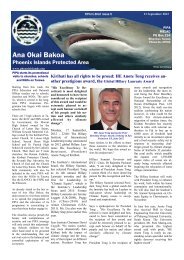Nomination for a World Heritage Site 2009 - Phoenix Islands ...
Nomination for a World Heritage Site 2009 - Phoenix Islands ...
Nomination for a World Heritage Site 2009 - Phoenix Islands ...
You also want an ePaper? Increase the reach of your titles
YUMPU automatically turns print PDFs into web optimized ePapers that Google loves.
EXECUTIVE SUMMARY<br />
State Party<br />
State, Province or Region<br />
Name of Property<br />
Geographical coordinates to the nearest second<br />
Textual description of the boundary(ies) of the<br />
nominated property<br />
Justification<br />
Statement of Outstanding Universal Value<br />
(text should clarify what is considered to be the<br />
outstanding universal value embodied by the<br />
nominated property)<br />
5<br />
Kiribati<br />
<strong>Phoenix</strong> <strong>Islands</strong><br />
<strong>Phoenix</strong> <strong>Islands</strong> Protected Area<br />
Longitude Latitude<br />
174.242794 0 W 0.983476 0 S<br />
169.706032 0 W 0.983476 0 S<br />
169.706032 0 W 6.466132 0 S<br />
173.220373 0 W 6.470758 0 S<br />
173.510230 0 W 6.616143 0 S<br />
175.865776 0 W 6.617835 0 S<br />
175.865776 0 W 2.091330 0 S<br />
PIPA‘s boundaries consists of a heptangular (7 corner points)<br />
shaped area that encompass some 408,250 sq km and includes<br />
8 atoll islands, two submerged reefs and at least 14 identified<br />
seamounts and their surrounding mainly deep water marine<br />
area.<br />
As a vast expanse of largely pristine mid-ocean environment,<br />
replete with a suite of largely intact uninhabited atolls, truly an<br />
oceanic wilderness, the PIPA, the largest marine protected<br />
area in the world (408,250 sq km), is globally exceptional and<br />
as such is a superlative natural phenomenon of global<br />
importance.<br />
A feature of the marine environment of PIPA is an<br />
outstanding collection of large submerged volcanoes,<br />
presumed extinct, rising direct from the extensive deep<br />
seafloor with an average depth of more than 4,500 metre and a<br />
maximum depth of over 6,000 metres. Included in the<br />
collection of large volcanoes are no less than 14 recognised<br />
seamounts, submerged mountains that don’t penetrate to the<br />
surface. The collection of atolls represent coral reef cappings<br />
on 8 other volcanic mountains that approach the surface.<br />
The large bathymetric range of the submerged seamount<br />
landscape provides depth defined habitat types fully<br />
representative of the mid oceanic biota. The widely<br />
recognized local endemicity and distinctive species<br />
assemblages associated with seamounts generally, specifically<br />
demonstrable in PIPA, is evidence of on-going insitu<br />
evolution of marine ecosystems and communities of plants<br />
and animals.<br />
PIPA is of crucial scientific importance in identifying and<br />
monitoring the processes of sea level change, growth rates and<br />
age of reefs and reef builders, (both geologically and<br />
historically) and in evaluating effects from climate change.<br />
The reef systems are so remote and exhibit such near pristine<br />
conditions that PIPA can serve as a benchmark <strong>for</strong>





